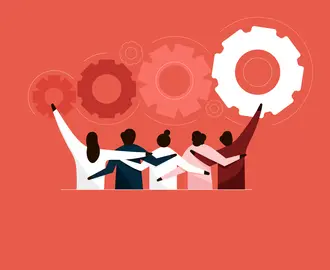Credit: Unsplash
New research from two MIT economists gives a whole new meaning to being asleep on the job.
In their paper “The Economic Consequences of Increasing Sleep Among the Urban Poor,” Pedro Bessone and Frank Schilbach found that after more than three weeks of daily 30-minute naps, employees at a data-entry job were 2.3% more productive and invested more of their money into savings accounts.
“These findings serve as a proof of concept that sleep can affect important economic outcomes relatively quickly,” the researchers write.
Bessone and Schilbach conducted their sleep research along with Heather Schofield of the University of Pennsylvania, and Gautam Rao and Mattie Toma, both from Harvard.
The research took place from October 2017 to April 2019, and involved randomly splitting 452 low-income workers in Chennai, India, into three groups: those who received treatments to increase their nighttime sleep at home, those given the opportunity to nap at their workplace to increase their daytime sleep, and a control group.
The researchers also measured savings behavior, by allowing the participants in either testing group to save money in a locked box at the study office, with randomly assigned daily interest rates between 0-2%.
At the end of each work day, after receiving money for their daily shift, the study participants could deposit or withdraw money from their savings boxes.
The nap treatment increased productivity in the workers’ data entry jobs, psychological well-being, as well as workers’ patience and attention, said Rao during a recent presentation at MIT.
The treatment that included additional nighttime sleep showed a minimal increase in workers’ productivity, and in fact the added time in bed led to a decrease in hours worked, causing a small decrease in earnings for those workers in the night-sleep treatment.
“Contrary to expert predictions and contrary to our own priors, we find that the night-sleep treatments basically have no positive effects,” Rao said.
The researchers based their study on the standard 7 to 9 hours of sleep recommended by sleep experts. The workers in the study got an average of 5.6 hours of sleep and woke up 32 times a night.
“Sleep could be particularly poor in cities in developing countries, where living environments are replete with irritants like noise, heat, and physical discomfort,” the study states.
According to a 2019 report, about 40% of Chennai’s population lives below the poverty line.
Here’s a closer look at their results:
Night-sleep treatment
Those in the night-sleep treatments were randomly divided into one of three groups:
- Sleep items: participants borrowed items like earplugs and eye masks, and were encouraged to sleep more.
- Sleep items and incentives: participants received the items and encouragement to increase their sleep, and earned 1 rupee per minute of increased sleep for up to two hours of increased sleep (120 rupees equaled about $1.70 at the time).
- Control: participants could not borrow items, and did not receive any of the encouragement nor monetary incentives to increase sleep.
All participants were provided with wristwatch-like actigraphs, devices that measured when someone was awake or asleep, as well as sleep quality through body motion.
On average, workers in the sleep items group increased their time asleep by 20 minutes, while those in the items and incentives group increased their time asleep by 33 minutes. Respectively, they increased their time in bed by 31 minutes and 46 minutes.
There was no change to the number of awakenings per hour during the night, and minimal improvement to the longest period of sleep.
The participants in this group saw a 1.3% increase in productivity, which was smaller than the 7% increase in output predicted by sleep and economics experts surveyed by the researchers.
The night treatment also reduced labor supply by about 10 minutes every day, since people were spending more time in bed and less time in the office.
“Contrary to our expectations, on average we do not find evidence that increasing night sleep had any effects on the outcomes we study,” Schilbach said. “We do find some evidence of productivity effects among people who enjoy better-quality sleep at the beginning of the study but even those effects are moderate. Overall, this evidence suggests that the profound effects found in the sleep literature may not extend to settings outside of sleep labs, especially for people with difficult sleeping conditions.”
Schilbach added that it’s important to note that the effects of the night sleep don’t necessarily extend to other settings, including the United States, since sleeping conditions and quality are so different in rich countries.
“A key question arising from our work is how to improve sleep quality among low-income workers, which could have high economic returns,” Schilbach said.
Nap treatment
For those in the nap treatment group, participants were given the opportunity to take a nap every day between 1:30 p.m. and 2 p.m. at their workplace.
The nap area was gender-separated, away from the working part of the office, and included things like a bed, pillow, table fan, ear plugs, and eye mask.
“While roughly 90% of individuals in this condition did indeed sleep during their allotted nap time, study participants who did not want to nap were asked to sit quietly or rest in their nap area,” the researchers write.
The participants who were not randomly assigned to the nap treatment group were further randomized — on a daily basis — into one of two conditions:
- Work through the nap period.
- Take a 30-minute break for a leisure activity or to sit in a break room.
While participants in the nap treatment group only spent about 13 minutes asleep, they were on average 2.3% more productive per day. They were also more alert to performance-pay incentives during the work day, and based on data collected on their well-being, appeared to be positively impacted by napping in terms of happiness and life satisfaction.
“Given the impacts on attention, it seems reasonable to expect that naps are more helpful for workers engaged in cognitively demanding tasks,” Schilbach said.
The people who were instructed to take naps also saved an additional 16 rupees per day into their savings boxes, equal to a 15% increase compared to the control group, the researchers found.
The researchers acknowledged that naps might be particularly beneficial in their study because the timing of the naps was chosen to coincide with a daily drop in energy for participants in the early afternoon. They also acknowledged that more sleep at night might show more effects over a longer period of time.
“Naps do not ‘pay for themselves,’ i.e. they do not increase overall output since they reduce overall hours worked,” Schilbach said. “However, firms might nevertheless want to offer naps to workers to improve the well-being and satisfaction of their workforce.”
The Economic Consequences of Increasing Sleep Among the Urban Poor.pdf



